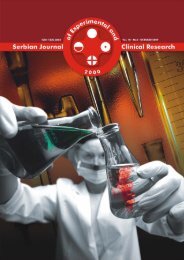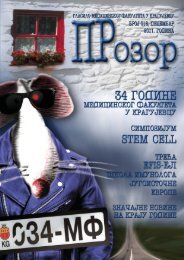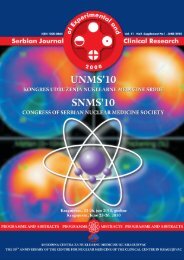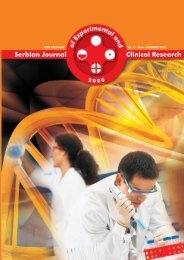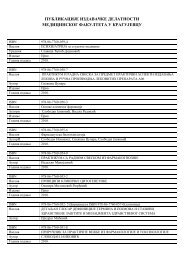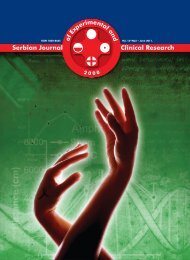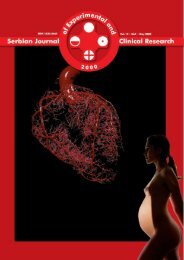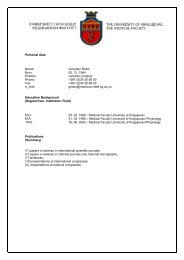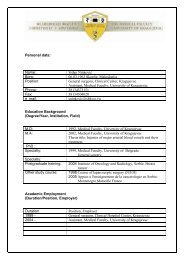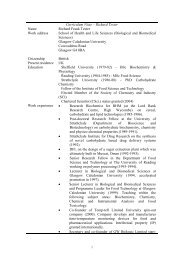neurotoxicity and mechanisms of induced hyperexcitability
neurotoxicity and mechanisms of induced hyperexcitability
neurotoxicity and mechanisms of induced hyperexcitability
You also want an ePaper? Increase the reach of your titles
YUMPU automatically turns print PDFs into web optimized ePapers that Google loves.
hanced glutamatergic transmission on the amphetamineresponse depends on the balance <strong>of</strong> NMDA <strong>and</strong> non-NMDA receptor activation interacting with dopamineD 1<strong>and</strong> D 2receptors. Both NMDA <strong>and</strong> non-NMDAreceptors in the nucleus accumbens are located at thepresynaptic level on glutamatergic <strong>and</strong> dopaminergicterminals arising from the cortex, the hippocampus <strong>and</strong>the midbrain, respectively (for a review see [63]). Ourresults suggest that serotonin depletion in the mPFCdoes not influence either dopaminergic or glutamatergictransmission within the nucleus accumbens.Serotonin in the mPFC <strong>and</strong> prepulse inhibitionPrepulse inhibition is thought to be mediated by a prefrontocortico-limbic-striato-pallidalcircuit in which themPFC plays an important role [64]. Manipulations thatdecrease dopamine levels in the mPFC disrupt prepulseinhibition [53, 54], presumably by disinhibition <strong>of</strong> the descendingglutamatergic projections [64]. The mPFC sendsdirect glutamatergic projections to the nucleus accumbens<strong>and</strong> the ventral tegmental area (VTA) [65], from which dopaminergicprojections ascend to the nucleus accumbens.Stimulation <strong>of</strong> the mPFC increases dopamine release inthe nucleus accumbens, probably via the VTA [66, 67]. Itis therefore possible that disinhibition <strong>of</strong> the mPFC glutamatergicoutput to the VTA increases dopamine release inthe nucleus accumbens <strong>and</strong> thereby reduces prepulse inhibition[68]. Our results suggest that serotonin depletion inthe mPFC does not alter mPFC output neurons to eitherthe VTA or the nucleus accumbens, thus having no effecton sensorimotor gating.In conclusion, serotonin depletion in the mPFC doesnot lead to the dysregulation <strong>of</strong> subcortical dopaminergicactivity <strong>and</strong> does not cause aberrant responses to environmentalstimuli. It is therefore clear that the behavioural effects<strong>of</strong> raphe lesions described in our initial studies [69,70] are not mediated by serotonin depletion in the mPFC.REFERENCES1. Awad, A.G. <strong>and</strong> L.N. Voruganti, Impact <strong>of</strong> atypical antipsychoticson quality <strong>of</strong> life in patients with schizophrenia.CNS Drugs, 2004. 18(13): p. 877-893.2. Harrison, P.J., The neuropathology <strong>of</strong> schizophrenia.Brain, 1999. 122: p. 593-624.3. Carlsson, A. <strong>and</strong> M. Lindqvist, Effect <strong>of</strong> chlorpromazineor haloperidol on formation <strong>of</strong> 3-methoxytyramine<strong>and</strong> normetanephrine in mouse brain. Acta PharmacolToxicol, 1963. 20: p. 140-144.4. Josselyn, S.A., R. Miller, <strong>and</strong> R.J. Beninger, Behavioraleffects <strong>of</strong> clozapine <strong>and</strong> dopamine receptor subtypes.Neurosci Biobehav Rev, 1997. 21(5): p. 531-558.5. Peroutka, S.J. <strong>and</strong> S.H. Synder, Relationship <strong>of</strong> neurolepticdrug effects at brain dopamine, serotonin, alphaadrenergic,<strong>and</strong> histamine receptors to clinical potency.Am J Psychiatry, 1980. 137(12): p. 1518-1522.6. Bymaster, F., et al., Olanzapine: a basic science update.Br J Psychiatry Suppl, 1999(37): p. 36-40.7. Carlsson, A., N. Waters, <strong>and</strong> M.L. Carlsson, Neurotransmitterinteractions in schizophrenia--therapeutic implications.Biol Psychiatry, 1999. 46(10): p. 1388-1395.8. Weiner, D.M., et al., 5-hydroxytryptamine2A receptorinverse agonists as antipsychotics. J Pharmacol ExpTher, 2001. 299(1): p. 268-276.9. Costall, B. <strong>and</strong> R.J. Naylor, Serotonin <strong>and</strong> psychiatricdisorders. A key to new therapeutic approaches. Arzneimittelforschung,1992. 42(2A): p. 246-249.10. Meston, C.M. <strong>and</strong> B.B. Gorzalka, Psychoactive drugs<strong>and</strong> human sexual behavior: the role <strong>of</strong> serotonergicactivity. J Psychoactive Drugs, 1992. 24(1): p. 1-40.11. Schlundt, D.G., et al., A sequential behavioral analysis<strong>of</strong> craving sweets in obese women. Addict Behav, 1993.18(1): p. 67-80.12. Azmitia, E.C. <strong>and</strong> P.M. Whitaker-Azmitia, Anatomy, cellbiology, <strong>and</strong> plasticity <strong>of</strong> the serotonergic system. Neuropsychopharmacologicalimplications for the actions <strong>of</strong>psychotropic drugs, in Psychopharmacology: the fourthgeneration <strong>of</strong> progress, F.E. Bloom <strong>and</strong> D.J. Kupfer, Editors.1995, Raven Press: New York. p. 443-449.13. Hornung, J.P., The human raphe nuclei <strong>and</strong> the serotonergicsystem. J Chem Neuroanat, 2003. 26(4): p. 331-343.14. Adell, A. <strong>and</strong> R.D. Myers, Selective destruction <strong>of</strong> midbrainraphe nuclei by 5,7-DHT: is brain 5-HT involvedin alcohol drinking in Sprague-Dawley rats? Brain Res,1995. 693(1-2): p. 70-79.15. McQuade, R. <strong>and</strong> T. Sharp, Functional mapping <strong>of</strong> dorsal<strong>and</strong> median raphe 5-hydroxytryptamine pathways inforebrain <strong>of</strong> the rat using microdialysis. J Neurochem,1997. 69(2): p. 791-796.16. Mokler, D.J., et al., Serotonin neuronal release fromdorsal hippocampus following electrical stimulation <strong>of</strong>the dorsal <strong>and</strong> median raphe nuclei in conscious rats.Hippocampus, 1998. 8(3): p. 262-273.17. Thomas, H., et al., Lesion <strong>of</strong> the median raphe nucleus:a combined behavioral <strong>and</strong> microdialysis study in rats.Pharmacol Biochem Behav, 2000. 65(1): p. 15-21.18. Abi-Dargham, A., et al., The role <strong>of</strong> serotonin in thepathophysiology <strong>and</strong> treatment <strong>of</strong> schizophrenia. JNeuropsych Clin Neurosci, 1997. 9(1): p. 1-17.19. Kapur, S. <strong>and</strong> G. Remington, Serotonin-dopamine interaction<strong>and</strong> its relevance to schizophrenia. Am J Psychiatry,1996. 153(4): p. 466-476.20. Geyer, M.A. <strong>and</strong> A. Markou, Animal models <strong>of</strong> psychiatricdisorders, in Psychopharmacology: the fourthgeneration <strong>of</strong> progress, F. Bloom <strong>and</strong> D. Kupfer, Editors.1995, Raven Press: New York. p. 787-798.21. Koch, M., Can animal models help to underst<strong>and</strong> hum<strong>and</strong>iseases? Commentary on Swerdlow et al., ‘Animal models<strong>of</strong> deficient sensorimotor gating: what we know, whatwe think we know, <strong>and</strong> what we hope to know soon’. BehavPharmacol, 2000. 11(3-4): p. 205-207.22. Matthysse, S., Animal models in psychiatric research.Prog Brain Res, 1986. 65: p. 259-270.17



